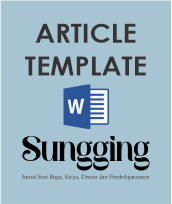Relief Medallions as a source of inspiration for artistic creations utilising wood waste
DOI:
https://doi.org/10.21831/sungging.v4i2.88823Keywords:
Wood waste , Limbah kayu, Artwork, Karya seni, Creative proses, Proses kreatifAbstract
In recent times, local culture has begun to be displaced by modernisation, and environmental awareness has declined. Therefore, efforts are needed to revive love for local culture and the environment. The purpose of this study is to create artwork with themes of local culture and the environment, namely, medallion reliefs and wood waste. Artwork featuring themes of local culture and the reuse of waste is one of the efforts to introduce, preserve, and conserve local culture and the environment through art. The research method employs Arts-Based Research. The artistic practice follows a three-stage experimental sequence: the exploration stage, the design stage, and the realisation stage. The results of this research indicate that wood waste has high potential for being utilised as an alternative medium for creating artworks. The result of this creative process is an environmentally friendly and affordable collage artwork themed around a medallion.
_______________________________________________________________________________
Beberapa waktu terakhir budaya lokal mulai tergeser oleh modernisasi, dan kecintaan terhadap lingkungan mengalami kemerosotan. Sehingga dibutuhkan suatu upaya untuk menumbuhkan kembali kecintaan budaya lokal dan lingkungan. Tujuan penelitian ini ialah untuk menciptakan karya seni dengan tema budaya lokal dan berbasis lingkungan yakni relief medalion dan limbah kayu. Karya seni dengan tema budaya lokal dan pemanfaatan limbah menjadi salah satu upaya untuk mengenalkan, menjaga dan melestarikan budaya lokal dan lingkungan melalui karya seni. Metode penelitian memakai Arts based Research. Praktek artistik menggunakan urutan eksperimen tiga tahap, yaitu: tahap eksplorasi, tahap perancangan, dan tahap perwujudan. Hasil dari penelitian ini menunjukan bahwa limbah kayu memiliki pontensi tinggi untuk dimanfaatkan menjadi alternatif medium penciptaan karya seni. Hasil proses kreatif ini yaitu karya seni kolase bertema medalion yang ramah lingkungan dan terjangkau.
References
DW Indonesia, 2021 ‘Kemasan Makanan Ramah Lingkungan dari Limbah Jerami padi’, https://youtu.be/OFjmETb-Abo accessed 23, December 2024.
Gustami, S. P. 2007. Butir-butir mutiara estetika timur: Ide dasar penciptaan seni kriya Indonesia [Eastern aesthetic pearls: The basic idea of creating Indonesian craft]. Prasista.
Nugroho, A.S., dkk. 2023 ‘Penguatan Karakter Peduli Lingkungan di Sekolah Dasar Melalui Karya Seni Ecoprint’, Jurnal Elementaria Edukasia, 6(2), pp. 762–777. Available at: https://doi.org/10.31949/jee.v6i2.5120.
Hepat, F.F.R. dkk. 2024 ‘Pelatihan Daur Ulang Kain Perca Sebagai Seni Ramah Lingkungan’, EJOIN : Jurnal Pengabdian Masyarakat, 2(4), pp. 671–677. https://doi.org/10.55681/ejoin.v2i4.2590.
Leavy, P. (2017). 'Research Design'. New York: The Guildford Press.
Riyani, M. 2015 ‘Local Genius Masyarakat Jawa Kuno Dalamrelief Candi Prambanan’, Jurnal Seuneubok Lada, 2(1), pp. 9–20. https://mail.ejurnalunsam.id/index.php/jsnbl/article/view/554.
Setyawan, H. dkk. 2020 ‘Interpretasi Relief Gandawyuha Di Candi Borobudur’, Jurnal Konservasi Cagar Budaya, 14(2), pp. 16–41. Available at: https://doi.org/10.33374/jurnalkonservasicagarbudaya.v14i2.
243.
Yuliana, T. & Bahari, N. (2023). ‘Utilisation of Agricultural Waste As a Medium for Art Creation’, Humanities, Arts and Social Sciences Studies, 23(3), pp. 609–617.






